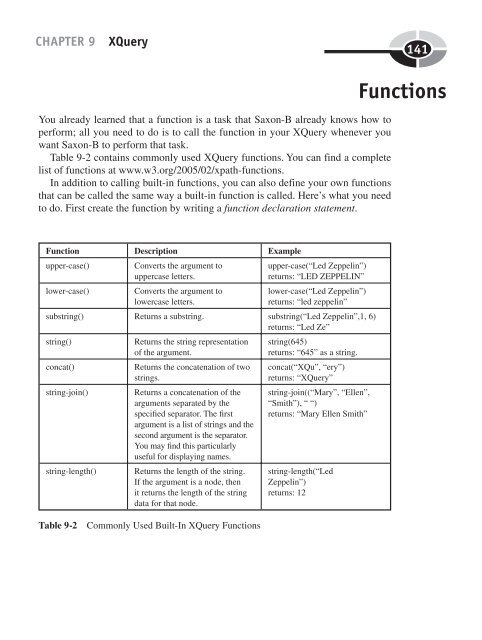You also want an ePaper? Increase the reach of your titles
YUMPU automatically turns print PDFs into web optimized ePapers that Google loves.
CHAPTER 9 XQuery<br />
You already learned that a function is a task that Saxon-B already knows how to<br />
perform; all you need to do is to call the function in your XQuery whenever you<br />
want Saxon-B to perform that task.<br />
Table 9-2 contains commonly used XQuery functions. You can find a complete<br />
list of functions at www.w3.org/2005/02/xpath-functions.<br />
In addition to calling built-in functions, you can also define your own functions<br />
that can be called the same way a built-in function is called. Here’s what you need<br />
to do. First create the function by writing a function declaration statement.<br />
Function Description Example<br />
upper-case() Converts the argument to<br />
uppercase letters.<br />
lower-case() Converts the argument to<br />
lowercase letters.<br />
upper-case(“Led Zeppelin”)<br />
returns: “LED ZEPPELIN”<br />
lower-case(“Led Zeppelin”)<br />
returns: “led zeppelin”<br />
substring() Returns a substring. substring(“Led Zeppelin”,1, 6)<br />
returns: “Led Ze”<br />
string() Returns the string representation<br />
of the argument.<br />
concat() Returns the concatenation of two<br />
strings.<br />
string-join() Returns a concatenation of the<br />
arguments separated by the<br />
specifi ed separator. The fi rst<br />
argument is a list of strings and the<br />
second argument is the separator.<br />
You may fi nd this particularly<br />
useful for displaying names.<br />
string-length() Returns the length of the string.<br />
If the argument is a node, then<br />
it returns the length of the string<br />
data for that node.<br />
Table 9-2 Commonly Used Built-In XQuery Functions<br />
string(645)<br />
returns: “645” as a string.<br />
concat(“XQu”, “ery”)<br />
returns: “XQuery”<br />
string-join((“Mary”, “Ellen”,<br />
“Smith”), “ “)<br />
returns: “Mary Ellen Smith”<br />
string-length(“Led<br />
Zeppelin”)<br />
returns: 12<br />
141<br />
Functions


